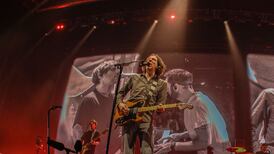Jim Reid, The Jesus and Mary Chain’s frontman, remembers an interview with mortification. On Belgian TV in 1986, a presenter opened by challenging the band’s “strange attitude” and the “chaos” that seemed to follow them. Reid’s softly spoken response involved dismissing the presenter’s favourite band, Joy Division – one of his own primary influences – as “particularly awful”, while Bobby Gillespie, the band’s drummer at the time, kissed his girlfriend on the same sofa.
Watching the clip now, it’s almost immediately legible as a performance. YouTube comments point out what we now call trolling. But it’s hard to control the way provocation is received. A new sort-of autobiography of the band shows how this worked incredibly well for the band in the beginning but came to define their career in ways that still make them uncomfortable.
Never Understood: The Jesus and Mary Chain recounts the lives of its founding members, William and Jim Reid, in their own voices. Three years apart, the brothers experienced different alienations in parallel. Born in a Glasgow tenement overlooking an Irn Bru factory, they moved to East Kilbride when they were still children. William missed his old life and friends. Jim, too young to have childhood memories of Glasgow, lacked even the comfort of a nostalgic connection to that city. Both boys were bored and lonely. They didn’t even understand each other – until they realised that their tastes in music, different from those of everyone around them, were identical.
When they eventually formed a band they wanted to “put the most offensive, loud, screeching guitars over the top of the bittersweet melodies of The Shangri-Las”. That’s exactly what their 1985 debut, Psychocandy, sounds like. Phil Spector arrangements with a washing machine on in the other room for the slower numbers, as on their classic Just Like Honey. Surf rock overlaid with what William calls “poisonous feedback” for the punkier ones.
The brothers always agreed “the songwriting would be 50/50”. And so is the narrative, ghostwritten with the music journalist Ben Thompson. Sections from the perspectives of William and Jim appear in different fonts. They approach their story as a tag team, William at first tougher, swaggery; Jim more sensitive and introverted. But in truth both brothers are equally shy and incendiary. And, as it goes, they start to give differing accounts, hinting at the disagreements that would lead to their dramatic split in 1998.
[ Jim Reid: ‘I’m not saying we’re all lovey-dovey: we still scream at each other’Opens in new window ]
The book’s finest part explores a sentimental education in Scotland and an early nous for self-marketing. Despite not playing the right sort of music to get a gig on the Glasgow scene, the brothers made fake live photos of themselves and put them up as posters. They played first in London, managed by the future Oasis impresario Alan McGee, then came back and wrote letters to Glasgow radio stations both praising and deriding themselves, “because you want to divide opinion when you’re starting out”.
They did. Fans rioted and the music press loved writing about them. But the savvy that allowed them to manage the effect they were producing didn’t follow them far into their major-label career. As much as they admit embarrassment at their naivety, they still seem to find it priggish that people didn’t like them turning up drunk to meetings with the Warner chief executive, or that promoters and TV runners wanted them sober enough to play their songs. It sometimes feels as if the shrift they were given was comparatively long.
Much of the book is poisonous feedback: railing against commercial successes of the age, popular taste, the music press and tabloids for interpreting provocation as provocation. Scores are settled with execs, producers, Iggy Pop’s road crew, and bands who didn’t make them feel welcome at Lollapalooza. All while detailing how they went about burning their own bridges.
The Mary Chain remain hugely beloved and influential. You instantly spot a sonic link between the Sex Pistols and the guitar bands of the 1990s. They anticipated the sounds of Britpop and grunge, which were to some extent answers to the same question.
By the Reids’ telling, they weren’t given the support to capitalise on this. But there’s no real evidence that earworms such as April Skies and Some Candy Talking could ever have been received like the irresistible, cogent hooks of Nirvana and Oasis with a bit more label favour.
None of this diminishes anything, because the Mary Chain’s main strength was always an atmosphere created by both their music and their persona. In a less charged 1986 interview, Jim Reid predicted that Psychocandy “will influence people to make more music”. You can hear them in The Libertines, the updated surf rock of The Drums and Beach Fossils, or Fat White Family. Their impact on music is audible.
And the coda to this pleasantly spiky and at times unpleasantly needy book indicates that the Reid brothers are accepting of this now, and doing well. There is some great BBC footage of them playing Just Like Honey at Glastonbury in 2022 with Phoebe Bridgers. Everyone is into it. What’s to misunderstand?













